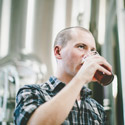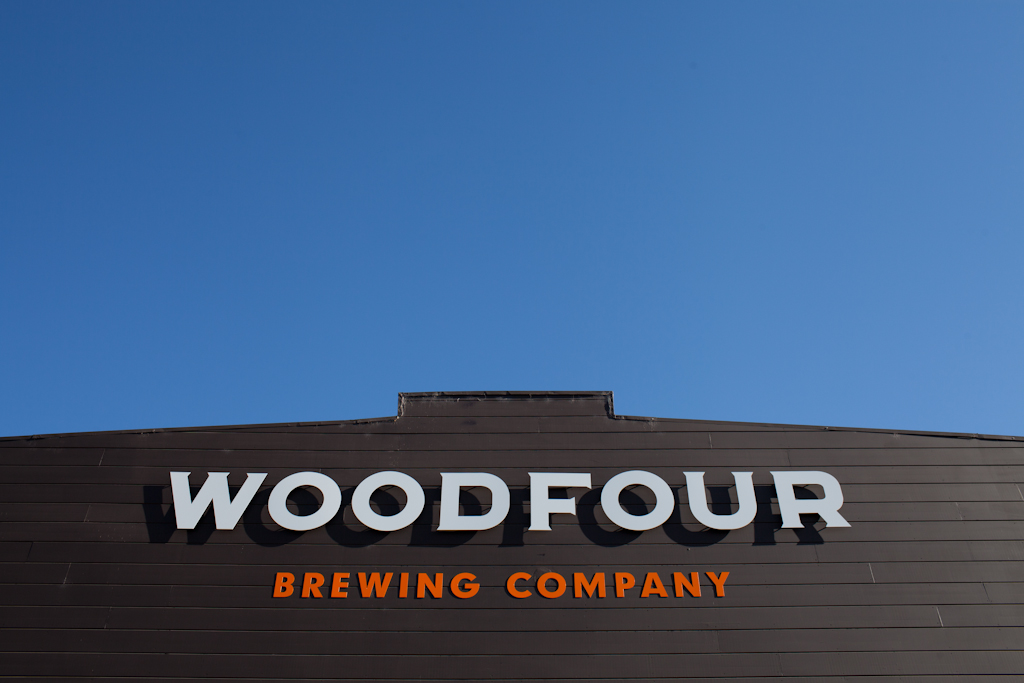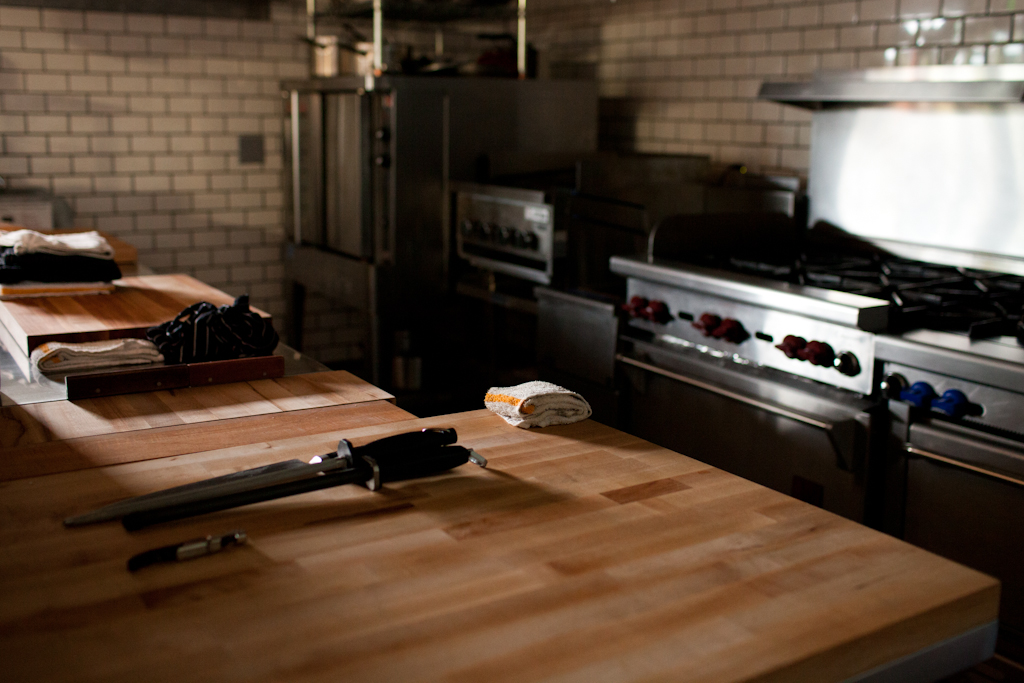Woodfour Brewing, a new start-up in Sonoma Valley, California, has international ambitions. No, they don't have some insane growth plan. In fact, they'll remain small for quite some time, tucked into the Barlow arts and commerce project in Sebastapol, California alongside small markets, wineries, glassblowers, and bakers. And they don't expect to set the world on fire with the extreme beers that came out of the California market in the first couple waves of craft brewing. They're making delicate, sessionable recipes like saisons, dubbels, and even a Roggenbier, an old German rye style.
To understand Woodfour's international outlook, you have to first understand the pair that founded the brewery — Olav Vier and Seth Wood. To that end, GBH collaborator Jeff Cagle spent a weekend with the team photographing the adventure and lending a hand to their hustle towards the grand opening. He worked alongside Olav and Seth, as well as chef Jamil Peden and sous chef Matthew Williams, watching them plate everything from a stout-battered rock cod to a chocolate torte with stout caramel.
But Jeff's biggest memory? Watching Olav build the "beer wall," which currently has 104 beers from around the world organized by country. "Olav spent a few days building the fixtures and securing the bottles before I hung them on the wall," recalls Jeff. "It has everything from a Westy 12 to a King Cobra inside a brown paper bag."
I followed up to get more of the Woodfour story.
Seth thought he was going to be a chef, or a wine maker.
"I went to culinary school in Hyde Park, NY at the Culinary Institute of America. I started to develop in beer through home brewing during culinary school. After that I worked in the restaurant industry and bounced around. Went back to school at Fresno State in their Enology program [wine studies]. I studied the science — biochemistry, organic chemistry, microbiology — but just continued this brewing thing the whole time."
Knowledge of chemical and analytical processes in beer is relatively fresh. After centuries of being treated like an intuitive art, most of the practices in beer requiring a science background were reserved for the larger macro brewers who needed to produce the same beer, hundreds of barrels at a time, in a dozen breweries around the country. But as the craft beer industry attracts more and more of this talent, this deep knowledge is being organically transferred down to smaller outfits, fueling growth through a more consistent, quality product. And professional associations like the American Society of Brewing Chemists are starting to entice small craft brewers with a need for the skills. It's a form of collaboration that most consumers, and even brewers, are largely unaware of between macro and micro brewing.
For Seth, this approach came from an even more unlikely place — the wine trade.
"That's where a different approach to the beer comes in. At Frenso State I started appreciating the analytical side, the articulated approach to wine making, which translates to beer. You're seeing more of it now. Brewers are trying to stand out more in that sea of 2,500 breweries. One thing a brewery has to do is maintain certain standards. A while back, just making good beer was enough. But now you need to constantly make good beer. It's not just a gamble, it's a science. Wine makers have a really articulated approach to what they do. I didn't see that so much in the beer world. There's more riding on it when you make wine. You have one shot, once a year and that's it, so you better not screw it up. In beer you can play with different things, experiment. But that wine makers' mentality really stuck with me."
Olav comes from the technology industry in San francisco by way of Berlin and he's Woodfour's sole investor. It's an unlikely transition, swapping out an industry that aims to scale as quickly as possible with little capital investment — often producing intangible software or patents — to an industry built on steel and concrete, and organic growth on the back of a product you literally bottle. But that seems to be just what attracted Olav.
"I like that. Brewing is a tangible product. People can value it and enjoy it. It's a much slower growth curve you're looking at, but that's not the goal of the business. The goal is to provide a great, lasting experience that people associate with your name and come back to again and again."
Olav's perceptions of the role that beer could play in our lives was deeply rooted in his German upbringing. For him, beer is an everyday occurrence paired with most meals. In the US, he was quite surprised with what was happening with craft beer. "In Germany it's a big lager landscape, and some wheat beers. The huge variety that we had 20-30 years ago has given way to a pretty bland selection of similar beers. This is an inspiration here in the US to start something new, and maybe even bring it home to Germany and reinvigorate the beer culture there."
When these two met in San Francisco, first over Craigslist (the internet is awesome) and then more officially over beers, it was Seth that had a vision for what a brewery could be about. He wanted to change people's perceptions of a beverage that's too often seen as "a little rough around the edges."
"When Seth said that to me it really resonated with my own perceptions." Olav said. "Beer is under appreciated. In Germany, all these old styles and old breweries we had in Bavaria were basically pushed aside by a few big players that tried to make beer a very homogenous mass-market product. Seth's appreciation for beer, and knowledge, and desire for the consumer to know about the variety out there — I thought that story needed to be told. The best way you can tell it is by producing the stuff and have a place where you can really celebrate it."
The Woodfour concept quickly gained momentum, and within a couple years, they signed on to a building in the Barlow development in Sebastapol. An abandoned industrial park on the edge of town, developer Barney Aldridge had a vision of a community of makers and producers in close quarters. So many artists and artisans toil away in their sheds in the hills of Sonoma, and Aldridge saw a chance to connect them with a vibrant community as creative business people. That ideal attracted Seth and Olav too.
"People here are interested in new things, and knowing where those things come from — who the people behind it are. We're surrounded by amazing beer that's already made a name for itself. You have Russian River 10 minutes away, Lagunitas is right down the road. Brian Hunt at Moonlight. Bear Republic. Sonoma County has a certain feel. To the untrained eye it might seem a lot like Napa. But Sonoma is distinct. A lot less pretense and a lot more getting-back-to-the-root of things. People creating things, making things with their hands. We saw the potential to have all these great neighbors, especially as a restaurant. We could be next door to someone making coffee. Right next to a farmers' distributor representing micro-local farmers. We have some of the best produce being dropped off 24/7. Even wineries. We have a barrel program we're starting that can take advantage of that connection, and the distillery next door. We couldn't think of a better place to put ourselves."
As the second tenant in the complex, Woodfour helped create a draw. They built a hybrid solar system on the roof (something that Olav was used to in Germany) that heats all the water for the brewery and the restaurant, as well as the radiant heat, dumping excess electricity back into the grid. They installed a modest 10-barrel brewhouse, aiming to produce upwards of 800 barrels in their first calendar year, and got brewing. But like many start-up breweries, they didn't have hop contracts, so they weren't going to be producing a lot of hop-forward recipes. Seth would have to rely on his other strengths instead.
"When I was at university I wrote a couple grants and got some funding to do some research on mixed yeast fermentations working with brettanomyces and things like that. Those are beer styles that get me excited. It's all open territory for playing and experimenting. A lot of what we do is fermentation-driven rather than hop-driven here. Which I guess is strange being on the west coast. People just assume that west coast is all big hoppy beers. We have a barrel-fermented summer ale that we fermented in pinot noir barrels with 100% brett. The Berliner Weiss goes through a traditional 4-day sour mash. So we're playing with different bugs. And alternative grains like the Roggensbier which we make with 50% rye."
Working with Seth has been a great education for Olav as well. "I learned that there's a world below 6%. I get feedback from customers that they love the beer, and they also love that they can drink a few. It's not the bold, masculine approach to craft beer. It's more subtle, with a finer touch. Even styles that are rare in Germany like the Berliner Weisse, which is only brewed by a few breweries in Berlin, are seen very positively here."
As craft brewers gain more technical expertise, the thought of nailing a recipe with only a few ingredients at a low ABV is less of a scary proposition that it used to be. And those beers are going to help us tap into a more mainstream audience that's curious about what beer has to offer. Seth and Olav are trying to move that needle in any direction they can, with whomever walks through the door.
"First question we always get is "which one is your IPA." explains Seth. "And we have to explain that actually none of them is an IPA. It's not that we don't like IPAs. But when you have the best IPA in the world being made 10 minutes away, for us, to just make another IPA isn't really what we're trying to do here. Not to say we'll never make one, but it's not the story we're trying to tell. So we walk through the whole list with people. They'll ask what's a Roggenbiere? What's a Berliner Weisse? And that's great. That's exactly what we want to happen. People won't just come flocking to us because we have the best version of something they're already familiar with. We see it as a curve. That's what we're about."
And Olav sees an opportunity to take that message back home to Germany as well. This past month, Olav helped coordinate a shipment of American craft beers to the Berlin beer festival with the goal of creating some attention in an otherwise stagnant beer culture — pouring some American craft brands there for the first time.
"After getting the Woodfour project off the ground, I had the idea of planting our flag in Germany for the first time at the festival in August in Berlin. Virtually no US craft beer is there, so I figured, why not make a US craft pavilion there. I talked to breweries participating in the export program — there are 19 alongside us. We organized a shipment to the festival and it was a huge success. I had a feeling that the Germans would go for some US lagers and Heffeweizens, but no. They really enjoyed the bold IPAs from Stone and the barrel aged ales and stouts. The demand is really there for exports beyond lager beers. Woodfour is a really small player. But we have some really interesting beers and some ideas of how we can grow craft beer abroad."
But before they get carried away with world domination, Woodfour is focusing on the task at hand — the brewpub. Seth and Olav have a refreshing view on the value that "taking it slow" can create. Rather than penetrate the market with their product, lining shelves and expanding their reach, they're much more content bringing customers into their world for awhile.
"The restaurant is really a stage. We have these ideas of how beer should be, how it should be treated with food and at the table. Once it leaves the loading dock and goes out into the world there's no control over how that beer is treated. It could end up exactly how we intend, next to some amazing food. Or it could end up in the back of a pickup truck on ice served out of plastic cups. There's nothing wrong with that, but for us, what we're doing in this physical space is our way of saying 'this is how we see beer, how we see it's place, and how it should be treated.' So our goal isn't to make a lot of beer and sell it elsewhere. The focus is really here. Any distribution we'll do isn't to add to our bottom line — it's to attract people back into our space. When someone leaves this place we want them to have a real experience. When they leave, and step back outside, they should almost forget where they parked their car because they forgot about the outside world for a little while. That's something you can only create if you have complete control over everything."

 Words, Michael Kiser
Photos, Jeff Cagle
Words, Michael Kiser
Photos, Jeff Cagle




























